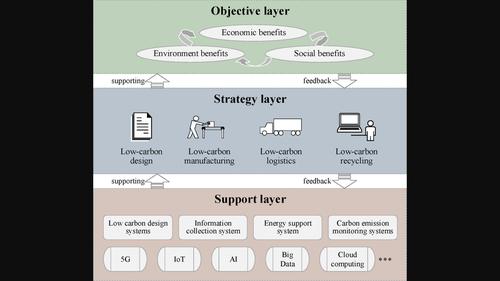产品低碳设计、制造、物流和回收:综述
IF 5.4
3区 工程技术
Q2 ENERGY & FUELS
引用次数: 0
摘要
由于世界气候危机的恶化,在整个产品运营过程中减少碳排放已成为制造业必须面对的问题。为了获得竞争优势,本文旨在探索产品生命周期的低碳设计技术:包括低碳设计、低碳制造、低碳物流和低碳回收,因为它们与减少碳排放高度相关。本文提出了一种低碳运营的投资组合结构,包括目标层、战略层和支持层,旨在提高能源效率和减少碳排放。为了强调经济、环境和社会优势的最大化,目标层建立了低碳产品设计的目标体系。战略层提出了四种低碳产品设计技术:低碳产品的设计、制造、运输和回收。支持层强调低碳产品运营系统和支持平台的重要性,如低碳设计系统、能源信息收集系统、能源优化支持系统、碳排放监测和控制系统以及低碳管理系统。然而,由于低碳制造的复杂性和每家公司的独特性,成功实施低碳制造具有挑战性。因此,本文建议将面向生命周期的低碳运营模型应用于各种制造企业,并探索反映实际制造实践的模型,以实现低碳制造的目标。本文章由计算机程序翻译,如有差异,请以英文原文为准。

Product low‐carbon design, manufacturing, logistics, and recycling: An overview
Due to the worsening world climate crisis, reducing carbon emissions throughout product operations has become an issue that the manufacturing industry must face. In order to gain competitive advantage, this paper aims to explore low carbon design techniques for product life cycle: including low carbon design, low carbon manufacturing, low carbon logistics and low carbon recycling, as they are highly relevant to reducing carbon emissions. This paper proposes a portfolio structure for low carbon operations, consisting of a target layer, a strategy layer, and a support layer, aimed at improving energy efficiency and reducing carbon emissions. To emphasize the maximization of economic, environmental, and social advantages, the objective layer establishes a system of goals for low‐carbon product design. The strategy layer proposes four low‐carbon product design technologies: low‐carbon product design, manufacturing, transportation, and recycling. The support layer emphasizes the importance of operational systems and support platforms for low‐carbon products, such as low‐carbon design systems, energy information collection systems, energy optimization support systems, carbon emission monitoring and control systems, and low‐carbon management systems. However, successful implementation of low carbon manufacturing is challenging due to the complexity of low carbon manufacturing and the uniqueness of each company. Therefore, this paper suggests applying a life‐cycle‐oriented low‐carbon operation model to various manufacturing enterprises and exploring models that reflect actual manufacturing practices to achieve the goal of low‐carbon manufacturing.
求助全文
通过发布文献求助,成功后即可免费获取论文全文。
去求助
来源期刊

Wiley Interdisciplinary Reviews-Energy and Environment
ENERGY & FUELS-
CiteScore
11.70
自引率
3.30%
发文量
42
期刊介绍:
Wiley Interdisciplinary Reviews: Energy and Environmentis a new type of review journal covering all aspects of energy technology, security and environmental impact.
Energy is one of the most critical resources for the welfare and prosperity of society. It also causes adverse environmental and societal effects, notably climate change which is the severest global problem in the modern age. Finding satisfactory solutions to the challenges ahead will need a linking of energy technology innovations, security, energy poverty, and environmental and climate impacts. The broad scope of energy issues demands collaboration between different disciplines of science and technology, and strong interaction between engineering, physical and life scientists, economists, sociologists and policy-makers.
 求助内容:
求助内容: 应助结果提醒方式:
应助结果提醒方式:


